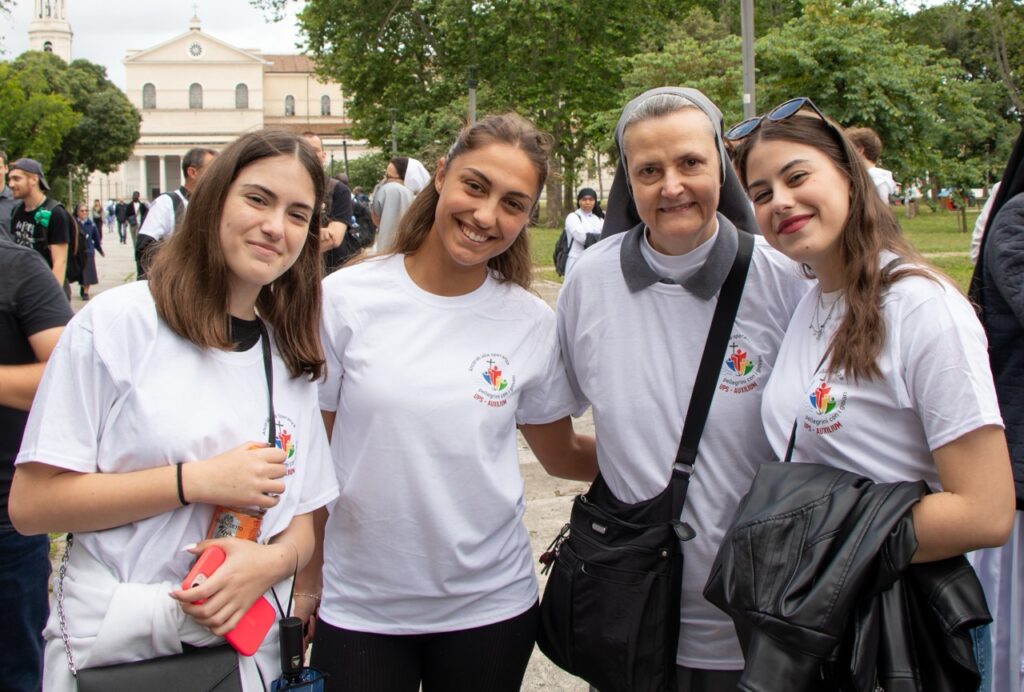Repairing the fractures of education: “There needs to be a balance between human, spiritual and professional growth”

Presence, community, and trust in young people: the keys to an education with a soul. Sister Piera Ruffinatto reflects on the Salesian legacy of Don Bosco and the path indicated by Pope Francis.
We interviewed Sister Piera Ruffinatto, Dean of the Pontifical Faculty of Educational Sciences Auxilium in Rome, the only pontifical faculty entrusted to a religious women’s institute. We talked with her about education, starting from the preventive method of Saint John Bosco to the Global Educational Pact promoted by Pope Francis. This dialogue touched on the knots of the educational crisis, not only in schools but also in human, social and cultural aspects.
Would you describe it as an emergency, as Pope Francis has, or as an urgency?
I believe the two terms are equivalent. What both express is the underlying problem, namely that today the meaning of being human is in question, partly due to the epochal change that Pope Francis himself speaks of. It is therefore urgent to reclaim what distinguishes us as people: relationship, meeting, community, family.
Pope Francis has left the Global Educational Pact as an educational legacy: an invitation to “network”, to grow together. How can we bring this call to life?
Pope Francis wanted to initiate a process, and despite COVID, he managed to convey that education is a responsibility of everyone, not just a few people or institutions. Something has moved: new alliances, collaborations, opportunities for dialogue and training, especially among adults. The Pope has indicated the Pact as a way to mend fractures: in families, institutions, between generations, and even within the person, between spirit, mind and hands.

What is the connection of this pact with Don Bosco?
Salesian pedagogy inherently contains the concept of educational alliance. Don Bosco’s dream was to create an “educating society,” engaging all types of people: the rich and the poor, the noble and the bourgeois, clergy and philanthropists, thinkers and politicians to work on the education of the new generations for the future of society.
Don Bosco also devised the preventive method, with insights that the Educational Pact revitalizes: care for relationships, trust in youth and community as an educating environment. How do these two pedagogical horizons interact?
Don Bosco and Pope Francis share a deep pedagogical convergence, centered on the person, relationships and community. Don Bosco, with his preventive method based on the triad of reason, religion and loving-kindness, and Pope Francis with the pedagogy of encounter to form head, heart and hands, both emphasize the importance of the educational environment and the integral formation of the person.
More in detail, what is Don Bosco’s preventive method?
It is an educational proposal that contrasts with the repressive systems prevalent in the 19th century, often characterized by violence and imposition, both in schools and families. It is based on a positive view of the person. Mistakes are not prevented through punishment, but through kindness, persuasion, educational presence, and the construction of a community environment capable of positively influencing the child and supporting them in their growth process.
Did Pope Francis experience this type of education?
At the age of 11, he spent a year in a Salesian boarding school in Buenos Aires, experiencing an educational approach that formed the youth comprehensively, without them even realizing it: intellectually, with studies oriented toward work and social integration, and spiritually, with attention to the formation of conscience and solidarity. Activities such as play, sports and theater were also present. Healthy competition was encouraged, lived out in a Christian manner, capable of fostering the integral and harmonious development of each youth’s potential.
Don Bosco and Pope Francis are not distant from each other.
They have aligned approaches to value all dimensions of a person, encouraging them to fully develop their resources. Pope Francis has often recalled with gratitude, pride and affection his Salesian experience, reaffirming its formative value.
Educating means presence, listening and concreteness. For Don Bosco, prevention coincided with living the lives of the youth: educating them with presence and loving-kindness. Is it possible today to educate in this way, or are we distracted by other things?
Don Bosco spoke of “houses,” not just boarding schools: educational communities that are family-oriented, attentive to the individual and based on meaningful relationships. His method, rooted in the Gospel, values loving-kindness, a family style, adult presence and accompaniment. Prevention means avoiding harm and promoting good, making the youth strong, free and responsible. I am sure that all of this is possible today, but it requires a genuine desire to listen lovingly to their educational questions.

A lot of concreteness…
Don Bosco was an educator. His method harmonizes various pedagogical elements embodied daily by an educational community of religious, laypeople, families and the territory, which deeply believes in the power of education. When lived with conviction, it works and is relevant because it is deeply connected to human nature. It is not always easy to implement because there is always the risk of falling into two extremes.
Such as?
Authoritarianism and laissez-faire, which is very prevalent today, suggesting that the youth should grow up on their own, with full autonomy and responsibility from a young age. But education needs guidance: a child must be guided while respecting their growth pace. Educating is an intentional action: the adult must know where they want to lead the child. This requires presence, self-control and the ability to manage one’s reactions, even when tired and stressed. Today, it is easy to lose patience and neglect relationships…
We need to return to this…
Certainly. We not only need to generate children biologically but also to life: to care for them, accompany them, and be with them. It is the most rewarding activity for a parent and a teacher.
Society evaluates people (and the youth) based on results. Don Bosco and Pope Francis invite us to believe in who they are, beyond the logic of performance. How can this trust be translated?
We live in a competitive and efficiency-driven society, which makes it difficult to educate while respecting individual timelines, even while talking about inclusion. Pope Francis denounces this contradiction: at the center is the economy, which demands high skills, and those who are fragile are left behind. Forcing the youth to achieve results generates anxiety, low self-esteem and insecurity. Schools must prepare students for work, but without reducing the person to mere labor. There needs to be a balance between human, spiritual and professional growth, valuing every resource of the youth.
A significant example is the encounter between Don Bosco and Michele Magone. Who was he?
A street boy like many today. He had no father, only his mother and lived on the streets. He seemed destined to be lost, but Don Bosco saw in him intelligence, a desire to change and sensitivity. He invited him to the oratory and put his educational art into practice: observing without judgment, seeking the “point accessible to good” that, according to him, exists even in the most unfortunate child. Don Bosco said that finding that point is the first task of the educator. It is about leveraging that to bring out the resources from within and trade them like talents.
What is Michele’s journey like?
He grows gradually, not immediately. He is supported by a serene, harmonious environment that guides him with respect. When Michele faces a deep moral crisis, he is ready to leave behind the “old boy” to embark on a new life. However, the change is not imposed by Don Bosco: he does not force choices but accompanies them patiently, waiting for the right moment.
Always with trust…
Unconditional in believing that no youth is lost. This is what made Michele Magone blossom: a look at what is and what can be. Don Bosco welcomes the youth as they are, observing their potential, and sees what they can become, betting on their capacity for change.
Pope Francis’ Educational Pact speaks of co-responsibility: no one educates alone. But in reality, families, schools and communities often seem fragile and isolated. How can this rift be mended?
The Educational Pact implies a common journey, as it is based on an agreement to be built and safeguarded together. When it breaks, there needs to be a willingness to mend it. We should not think that it is entirely absent today: in Salesian schools, we see educating communities where parents, teachers, students and staff grow together and develop a sense of belonging. The Pact arises from the awareness that education concerns us, it “touches” us. From here comes the willingness to put resources at stake as an act of collaboration.

A bit of hope…
Today’s world distracts and fragments. Time is lacking, a fundamental ingredient for forming alliances. But if we truly believe in the value of this pact, we can make priority choices, even in small steps. There are such experiences in schools and parishes.
Don Bosco helps us with effective images. Which ones?
The image of the beehive: many bees with different but complementary roles, working in harmony. It is a lively, industrious, satisfied community that serves life: the “queen,” meaning the new generations to be nurtured.
Or?
The basket woven with willow branches. One alone cannot hold anything. Woven together with others, it forms a strong container that can support a great weight. Alone, in the face of today’s educational challenges, we can do little. These images remind us that educating requires a “village,” as Pope Francis says. If we join forces, we can become a community that generates life.
In a landscape still marked by male leadership, a pontifical faculty led by women feels revolutionary. What changes when education is led by them?
The female contribution does not oppose the male one. A vision of reciprocity is appropriate: neither opposition nor mere complementarity, but diversity that enriches humanity together. Even today, it is difficult to fully grasp the wealth of the female contribution in society, politics and work. In the field of education, it can be a great advantage because the female perspective is generative: women, by nature, are oriented towards life, not only biologically but in their entire being. They have a perspective capable of synthesis, of identifying the weakest and allying with them. A mother instinctively moves towards her most needy child. The female educational style is inclusive; it knows how to care for and protect, but also encourages stepping out of the nest, to fly away and face life with courage.
Is it important to value this perspective with public and institutional recognition?
The Auxilium Faculty is the only one entrusted to a female institute in the landscape of pontifical universities. The Holy See has entrusted it to the Institute of the Daughters of Mary Help of Christians, founded by Saint John Bosco in 1872 for the integral education of the youth from popular classes. As a faculty, we were established in 1970, adopting the motto: “With Mary, for a culture of life.”
How was it chosen?
We are inspired by Mary Help of Christians, guide and guardian of life, who, with Saint Joseph, provided a family for the Son of God. Our educational offering, based on Christian values, promotes the dignity of life and contributes, through scientific research, teaching and a third mission, to building a more just and supportive society.
